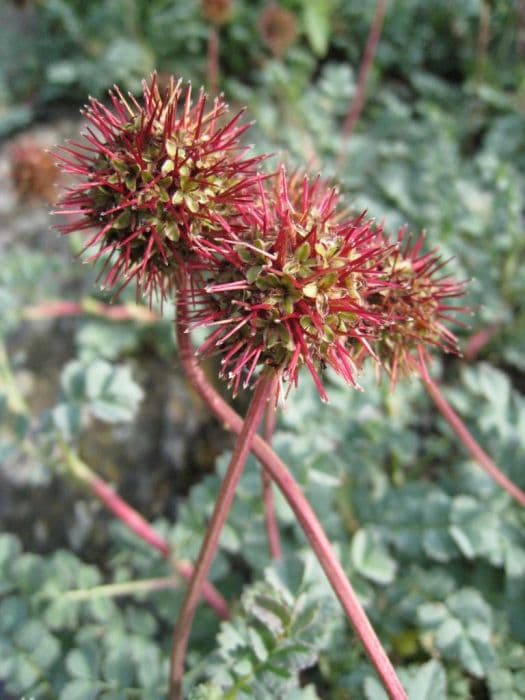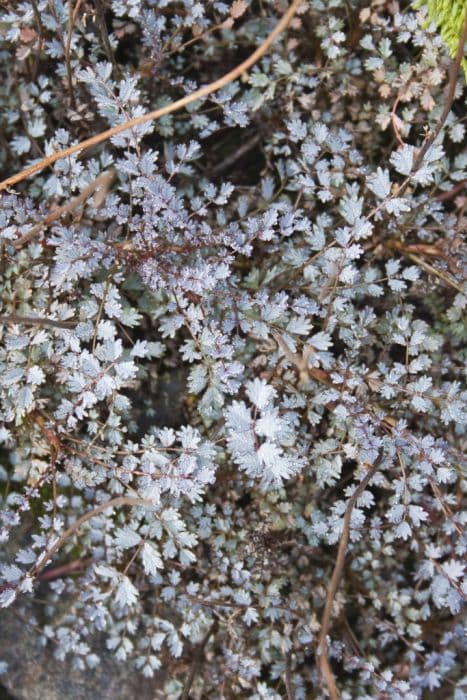Ward's Mountain Ash Sorbus wardii

ABOUT
Sorbus wardii, more commonly known as the rowan, is characterized by a graceful appearance with a number of features that make it quite attractive throughout the year. The rowan displays a lush foliage that emerges as a soft green in the spring and transitions to a deeper hue as the season progresses. Each leaf is made up of multiple leaflets arranged in a feather-like pattern, which is commonly seen in members of this plant family. Come autumn, the foliage transforms once more, offering a vibrant display of colors ranging from rich golds to fiery reds and oranges, providing a striking contrast against the autumn landscape. This colorful display is one of the hallmarks of the rowan, making it a favorite among those who appreciate fall colors. The flowers of the rowan are typically small and white, blossoming in dense clusters known as corymbs, which create a snowy effect when they are in full bloom. After the flowering season, these blossoms give way to berries. The berries are usually bright red or orange, and they persist on the branches well into winter, adding a splash of color to the plant's surroundings, as well as providing a food source for various bird species during the colder months. The bark of the rowan is another notable characteristic, being smooth with a silver-gray appearance that adds to the overall elegance of the plant. The trunk and branches seem to be crafted with an eye for structure, perfectly supporting the canopy of leaves, flowers, and berries, while also providing an interesting visual texture. The smooth bark is occasionally interrupted by fissures and lenticels, which offer an intricate pattern and help in the exchange of gases. While the size and scale of the rowan can be impressive, it is the interplay of the plant's foliage, flowers, berries, and bark that truly captures attention and makes it an appealing choice for ornamental use in various landscapes. The rowan's versatility in terms of seasonal interest ensures that it maintains a prominent and attractive presence throughout the year.
About this plant
 Names
NamesFamily
Rosaceae
Synonyms
Ward's Mountain Ash
Common names
Sorbus wardii.
 Toxicity
ToxicityTo humans
Sorbus wardii, commonly known as Ward's rowan, is not frequently reported to be toxic to humans. However, as with many plants in the Sorbus genus, its seeds may contain substances that could potentially be harmful if consumed in large quantities. These substances can include cyanogenic glycosides, which can release cyanide when digested. If cyanide is released in the body, it can lead to symptoms such as headache, nausea, vomiting, abdominal pain, dizziness, confusion, seizures, and in extreme cases, can be fatal. It is generally advised not to eat the seeds of Sorbus species, and caution should be exercised when handling any unfamiliar plant.
To pets
Sorbus wardii, or Ward's rowan, has not been specifically documented for its toxicity to pets, but it is wise to consider that the seeds may contain cyanogenic glycosides, similar to other plants in the Sorbus genus. These compounds can release cyanide when ingested, which is toxic to both humans and animals. If pets consume a significant amount of the seeds, they might exhibit symptoms such as salivation, difficulty breathing, and gastrointestinal distress. In severe cases, seizures, collapse, and even death could occur. Pet owners should prevent their animals from ingesting the seeds or leaves of this plant to avoid any potential risk.
 Characteristics
CharacteristicsLife cycle
Perennials
Foliage type
Deciduous
Color of leaves
Green
Flower color
White
Height
20 feet (6 meters)
Spread
15 feet (4.5 meters)
Plant type
Tree
Hardiness zones
6
Native area
China
Benefits
 General Benefits
General Benefits- Wildlife Habitat: Provides shelter and food for birds and other wildlife species.
- Aesthetic Appeal: Adds visual interest to landscapes with its foliage and fruit.
- Erosion Control: Helps stabilize soil with its root system.
- Seasonal Interest: Offers year-round visual changes, from flowers to fruit to fall color.
- Tolerance of Conditions: Adapts to a range of soil types and climates.
- Shade Provision: Offers shade in gardens and public spaces.
- Cultural Significance: May have historical or cultural importance in certain regions.
- Pollinator Support: Flowers can attract and support bees and other pollinators.
 Medical Properties
Medical PropertiesThis plant is not used for medical purposes.
 Air-purifying Qualities
Air-purifying QualitiesThis plant is not specifically known for air purifying qualities.
 Other Uses
Other Uses- The wood of Mountain Ash can be used for crafting small wooden objects such as bowls or tool handles, owing to its fine grain and workability.
- Due to its resilience, the wood is also suitable for turning on a lathe to create artistic shapes and sculptures.
- The tree's decorative berries can be used for ornamental purposes in floral arrangements or as natural Christmas decorations.
- The leaves of Mountain Ash are compostable and can contribute to a nutrient-rich mulch for garden beds.
- Its dense canopy can serve as a good shading option in landscape design to create cooler, shaded areas in gardens.
- The branches of the Mountain Ash can be utilized as natural trellises for climbing plants in a garden.
- When pruned properly, they can form a living fence or privacy screen in suburban and rural landscapes.
- The blossoms of Mountain Ash can be pressed and used in traditional crafts such as botanical prints or natural art pieces.
- The tree's natural form and vibrant colors make it an attractive subject for photography and nature-based art projects.
- Its berries can be fermented to create dyes for fabrics or inks for artistic endeavors, offering a range of natural colors.
Interesting Facts
 Feng Shui
Feng ShuiThe Rowan is not used in Feng Shui practice.
 Zodiac Sign Compitability
Zodiac Sign CompitabilityThe Rowan is not used in astrology practice.
 Plant Symbolism
Plant Symbolism- Endurance: Sorbus wardii, commonly known as Rowan, is often associated with endurance due to its ability to thrive in harsh climates and poor soils.
- Protection: The Rowan is thought to ward off evil and is used in folklore as a charm against witches, which is why it’s commonly planted near homes and in gardens.
- Wisdom: In some cultures, the Rowan is a symbol of wisdom and knowledge, perhaps due to its long lifespan and its association with ancient lore.
- Courage: The Rowan tree is also a symbol of courage, reflecting the bravery required to face life's challenges, similar to how the tree stands strong against the elements.
 Water
WaterThe Tibetan Whitebeam, which is a common name for Sorbus wardii, prefers consistent moisture, but does not do well with waterlogged roots, so ensure well-draining soil. During the active growth seasons of spring and summer, water the plant deeply once a week, using approximately 1-2 gallons per watering, depending on the size and maturity of the tree. In the fall and winter, reduce the frequency to every other week or when the soil feels dry to the touch. Always check the top couple of inches of soil for dryness before watering to avoid overwatering. It’s important to avoid letting the plant sit in standing water to prevent root rot.
 Light
LightThe Tibetan Whitebeam thrives best in full sun to partial shade. An ideal spot would be one where the plant receives at least six hours of direct sunlight per day, with some dappled shade in the afternoon to protect it from the intense heat. Avoid deep shade locations, as this can lead to reduced vigor and fewer flowers.
 Temperature
TemperatureThe Tibetan Whitebeam is adapted to a wide range of temperature conditions but prefers a cooler climate. It can tolerate temperatures down to about -20 degrees Fahrenheit in the winter and can withstand summer temperatures as high as 85 degrees Fahrenheit. The ideal temperature range for this plant is between 50 and 75 degrees Fahrenheit. Make sure to provide protection from extreme temperature fluctuations to maintain its health and appearance.
 Pruning
PruningThe Tibetan Whitebeam should be pruned to maintain its shape and remove any dead or diseased branches. The best time to prune is during the dormant season, late winter or early spring, before new growth starts. Pruning once a year is typically sufficient to keep the plant healthy and well-structured. Make sure to use clean, sharp tools to make clean cuts that will heal quickly.
 Cleaning
CleaningAs needed
 Soil
SoilSorbus wardii, commonly known as Rowan or Mountain Ash, requires well-draining soil with added organic matter. A loamy soil with a pH between 5.5 to 7.0 suits it well. A mix composed of garden soil, compost, and perlite or vermiculite will provide the necessary nutrients and drainage.
 Repotting
RepottingMountain Ashes, including Sorbus wardii, do not need frequent repotting and prefer to be left undisturbed. They can typically be repotted every 3-5 years, or when the plant has outgrown its current container.
 Humidity & Misting
Humidity & MistingSorbus wardii, known as the Rowan or Mountain Ash, prefers moderate humidity levels. It does not have high humidity requirements and can adapt to the ambient outdoor humidity in most temperate regions.
 Suitable locations
Suitable locationsIndoor
Place in bright, indirect light and avoid dry, hot spots.
Outdoor
Plant in well-draining soil, full sun to partial shade.
Hardiness zone
5-7 USDA
 Life cycle
Life cycleSorbus wardii, more commonly known as Ward's mountain ash, begins its life cycle as a seed, which germinates in spring if conditions are suitable—moist soil and ample sunlight. Following germination, a seedling emerges and develops into a young sapling; during this juvenile phase, the plant puts much energy into root and foliage growth. As the sapling matures, it grows into an adult tree capable of flowering; Ward's mountain ash usually flowers in late spring, bearing clusters of white blossoms that attract pollinators. Once pollinated, the flowers develop into berry-like pomes that mature by autumn, providing a food source for birds and other wildlife. The seeds within the fruit may be dispersed by these animals, propagating the species to new locations. Eventually, after many years of growth and seasonal cycles, the plant will reach the end of its life span, which may be several decades, having contributed to the ecosystem and regeneration of its species through seed production.
 Propogation
PropogationPropogation time
Spring to early summer
The Mountain Ash, also known as Sorbus wardii, is a tree that is typically propagated through seed sowing. The most popular method of propagation for this species is by collecting the seeds from ripe berries. Once collected, the seeds should be cleaned and then subjected to a cold stratification process, which simulates winter conditions. This can be achieved by mixing the seeds with slightly moist sand and placing them in a refrigerator at approximately 34 to 41 degrees Fahrenheit (1 to 5 degrees Celsius) for around 90 to 120 days. After cold stratification, the seeds can be sown in pots or a nursery bed in the spring. Germination may be slow and uneven, but with patience, seedlings will eventually emerge and can then be nurtured until they are ready to be transplanted to their permanent locations.









